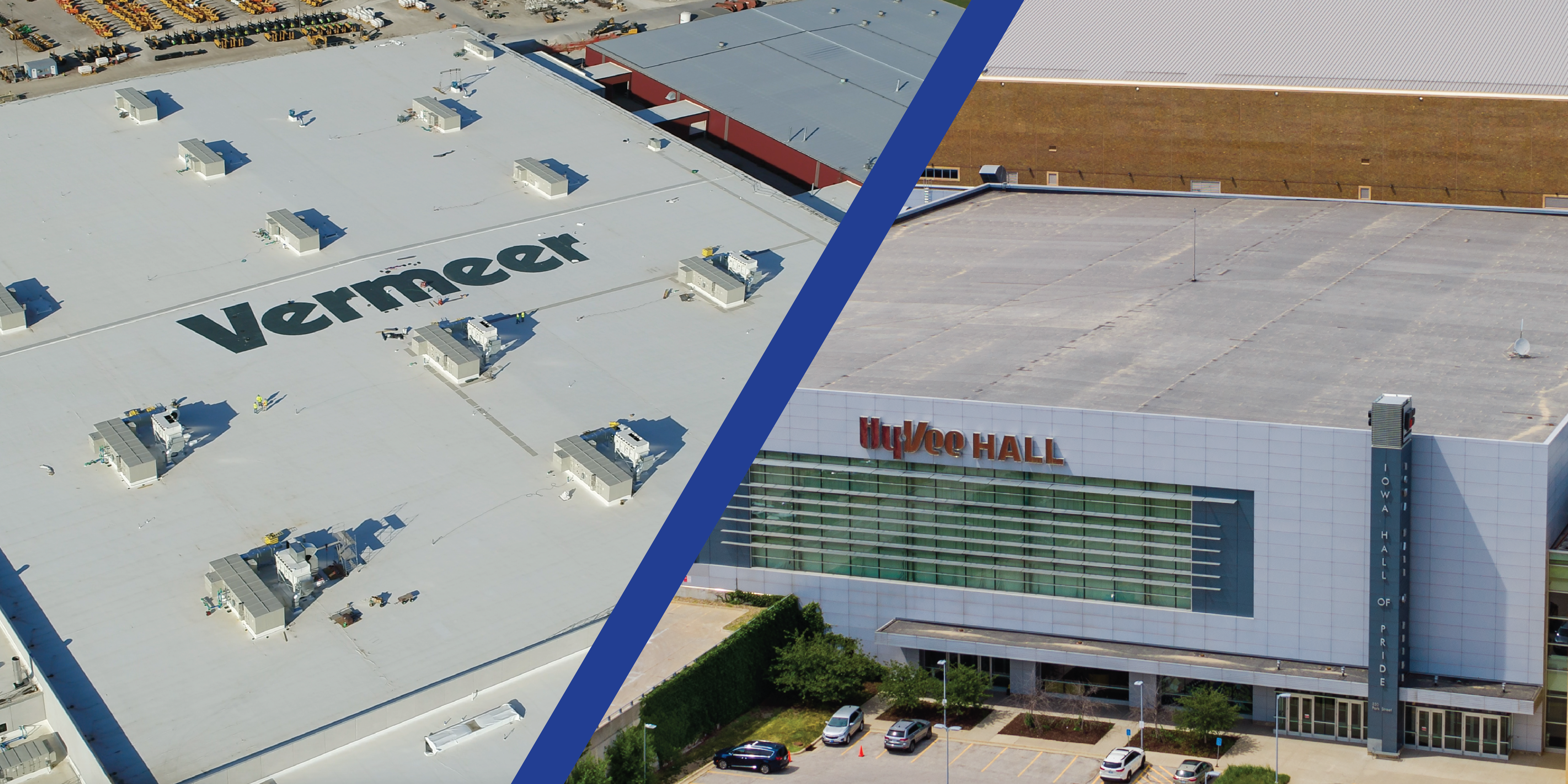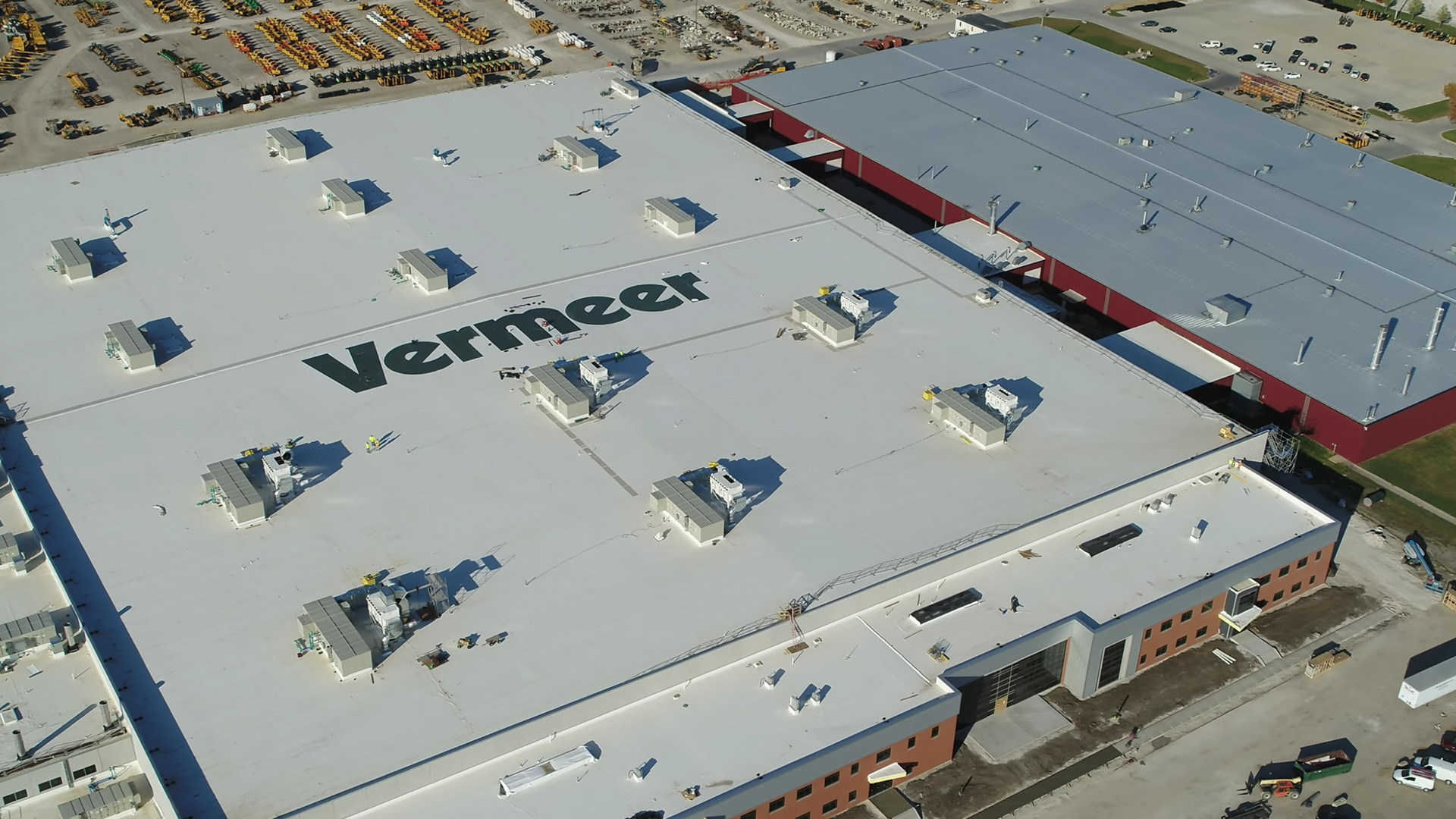When it comes to selecting the right roofing material for your commercial property, there are two popular options: TPO and EPDM. When deciding between the two, it’s essential to understand the differences and benefits of each. Ready to compare TPO and EPDM, so you can make an informed decision? Let’s get started!
What is TPO?
TPO, or thermoplastic polyolefin, is a single-ply roofing membrane that is engineered using a combination of polypropylene and ethylene-propylene rubber. This synthetic rubber roofing material is known for its durability, energy efficiency, and ease of installation. The seams of a TPO roofing system are heat-welded during installation, creating a strong and watertight seal. TPO is typically secured to a roof using mechanical plates and fasteners, RhinoBond induction welding, or by fully adhering using TPO bonding adhesive.
What is EPDM?
EPDM, or ethylene propylene diene monomer, is a single-ply roofing membrane made from synthetic rubber. The seams of an EPDM roofing system use seam tape to create a watertight seal. Non-reinforced EPDM roofs have no reinforcing scrim and are most commonly secured to the roof by fully adhering with EPDM bonding adhesive or using rock ballast. An EPDM roof cannot be secured with mechanical plates and fasteners unless it is an EPDM product with a reinforcing scrim.
How are TPO and EPDM different?
- Composition: TPO is made from a blend of polypropylene and ethylene-propylene rubber, while EPDM is composed of synthetic rubber.
- Installation: TPO membrane seams are heat-welded together during installation, whereas EPDM roof seams are made watertight by seam tape. You can mechanically fasten, RhinoBond induction weld, or fully adhere TPO. You can fully adhere or ballast an EPDM membrane.
- Durability: Both TPO and EPDM roofing membranes come in a variety of thicknesses. Typical TPO membrane thicknesses are 45 mil, 60 mil, and 80 mil. Typical EPDM membrane thicknesses are 45 mil, 60 mil, and 90 mil. The thicker the membrane, the more resilient the roof will be to foot traffic, hail damage, and other work that requires being on your roof. Another way to boost the durability of the membrane is to choose a high-density insulation or coverboard to go underneath the membrane to help support it. TPO roofs are known for their resistance to UV rays and chemical exposure, making them more durable over time. EPDM is also durable, but may require more maintenance in harsh climates.
- Energy efficiency: TPO roofs typically come in reflective white colors, which can help reduce energy consumption by reflecting sunlight. Because of this, people often refer to TPO as white rubber. EPDM is often darker and may not offer the same level of energy efficiency. For example, in Iowa, the weather is split almost 50/50 on hot and cold days. This means that the color of the roof plays less of a role in heating and cooling because only half of the year it would be working toward that energy goal. In Iowa, the most important factor for thermal assistance is making sure you have a good roof R-value. The R-value is calculated by the type and thickness of insulation that is on your roof. Typical building codes ask for R25 or R30 insulation.
How many years do TPO and EPDM roofs last?
When properly installed and maintained, both TPO and EPDM roofing systems can last for several decades. TPO roofs generally have a lifespan of 20 to 30 years, while EPDM roofs can last around 25 to 30 years. Regular inspections and maintenance can extend the longevity of both roofing types.
How are they installed?
TPO and EPDM roofs are installed by certified roofing contractors with experience in working with single-ply membranes. The seams of TPO are heat-welded during installation, creating a watertight bond. TPO roofs are either fully adhered using adhesive or mechanically attached using fasteners. EPDM roofs will be fully adhered or ballasted.
What type is better for commercial roofing?
Both TPO and EPDM have their advantages, making the choice dependent on specific project requirements and budget considerations. TPO’s heat-welded seams provide excellent waterproofing, making it suitable for roofs with complex shapes. EPDM’s flexibility and proven track record make it a reliable choice for a variety of commercial applications. Both materials offer exceptional durability and resistance to various weather conditions, making them suitable for most commercial applications.
Which type is more popular in the commercial roofing industry?
TPO is considered one of the fastest-growing commercial roofing systems due to its modern technology, energy efficiency, and installation benefits. However, EPDM remains a popular choice, particularly for buildings with large, flat roof surfaces.
Can TPO and EPDM be installed on existing roofs?
Yes, both TPO and EPDM roofing systems can often be installed over existing roofs, depending on the condition of the current roof and the building code in your state. Typically, the building code says two roofs (for example, your existing roof in addition to a TPO or EPDM system) is the maximum amount that can be on a building at one time.
During the inspection, if it is discovered that there is only one existing roof, then the option to install a second roof over the existing one is a potential option. If two roofs are discovered, best practice is to remove all the existing roofing down to the structural deck. However, if the roof is deemed in good enough shape, then removing the top layer of roofing down to the first layer of roofing can be considered.
All of this information would be determined during the inspection. Installing a new roof over an existing roof can save time and money by eliminating the need for a complete tear-off. It’s essential, though, to have a professional assessment to determine if this is a viable option for your specific roof.
What maintenance practices are recommended for a flat roof?
Find OutWhat are the benefits of each?
TPO benefits:
- Energy efficient due to reflective surfaces
- Resistant to UV rays and chemicals
- Heat-welded seams provide superior waterproofing
- Modern technology and fast installation
- Versatile for different roof shapes
EPDM benefits:
- Proven durability and longevity
- Highly flexible, accommodating building movement
- Good resistance to extreme temperatures without deteriorating
- Suitable for both flat and low-sloped roofs
- Cost-effective
What factors should you consider when deciding between TPO and EPDM?
- Climate: Consider your local climate and weather conditions. TPO’s UV resistance may be beneficial in sunny areas, while EPDM’s flexibility can withstand temperature fluctuations.
- Energy efficiency: If energy efficiency is a top priority for you, TPO’s reflective properties can help reduce cooling costs and lower your building’s environmental impact.
- Installation method: Think about the installation process that best aligns with your project’s needs and timeline. TPO’s heat-welded seams create a seamless barrier, while EPDM’s adhesive or mechanical attachments offer different installation methods.
- Budget: Evaluate your budget constraints and compare the costs of both materials, including installation and maintenance expenses.
- Warranty: Investigate the warranties offered by manufacturers for both TPO and EPDM systems. A comprehensive warranty can provide additional peace of mind for your investment.
- Roof design: The complexity of your roof’s design can influence which material is more suitable.
Which type is more expensive per square foot?
The cost per square foot for TPO and EPDM can vary depending on factors like the brand, thickness, and specific project requirements. Generally, EPDM is considered to be more expensive due to the make-up of the product itself, and the compatible materials it requires to complete the system. TPO tends to be slightly less expensive per square foot due to its installation versatility and more compatible insulation options.
So which one should you choose?
TPO and EPDM are both strong contenders for commercial roofing projects, and the decision between the two ultimately comes down to individual needs, budget, and preferences. TPO’s energy efficiency and ease of installation have contributed to its rise in popularity, while EPDM’s proven performance and weather resistance continue to make it a reliable choice.
Still unsure?
Schedule a consultation with one of our experienced roofing experts. We’ll assess your specific needs, budget, and building requirements to recommend the best solution tailored to your project. When you are ready to move forward, we will be ready to perform a successful roofing installation that will protect your investment for years to come.
Call us today to request a free consultation.





